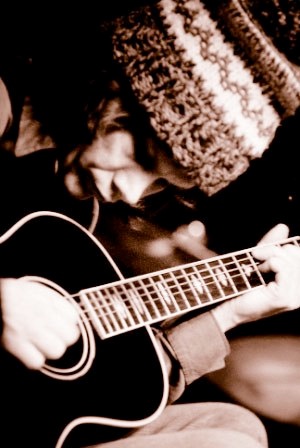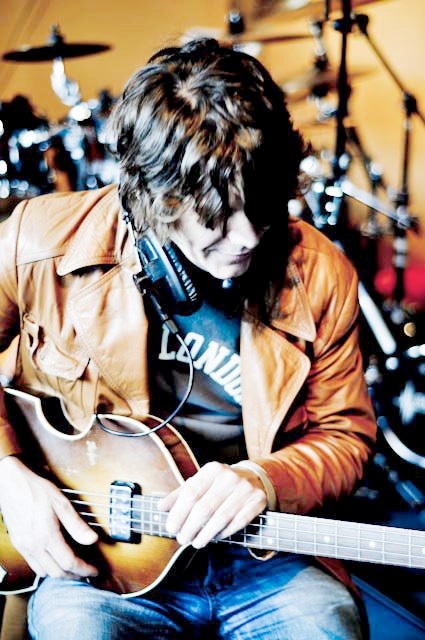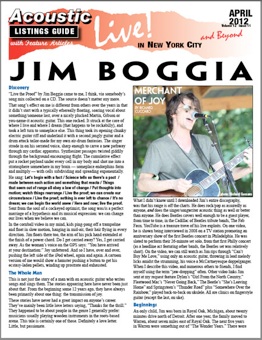Jim Boggia
Merchant of Joy
By Richard Cuccaro
Discovery
“Live the Proof” by Jim Boggia came to me, I think, via somebody’s song mix collected on a CD. The source doesn’t matter anymore.
That song’s effect on me is different from others over the years in that it didn’t start with a typically ethereally floating, soaring vocal about something/someone lost, over a nicely plucked Martin, Gibson or you-name-it acoustic guitar. This one rocked. It struck at the core of where I live and where I dream (that happens to be rockabilly), and took a left turn to someplace else. This thing took its opening chunky electric guitar riff and underlaid it with a second jangly guitar and a drum attack tailor-made for my own air-drum fantasies. The singer strode in on his serrated voice, sharp enough to carve a new pathway through my cardiac apparatus. Synthesizer passages twisted giddily through the background, encouraging flight. The cumulative effect put a rocket payload under every cell in my body and shot me into a stratosphere somewhere in my brain — someplace endorphins form and multiply — with cells subdividing and spreading exponentially.
He sang: Let’s begin with a fact / Science tells us there’s a pact / made between each action and something that reacts / Things that seem out of range all obey a law of change / Put thoughts into motion; watch things rearrange / Live the proof; we can create our circumstance / Live the proof; nothing is ever left to chance / It’s no dream; we can begin the world anew / Here and now; live the proof. Sent from the soul of a cockeyed optimist, the song was/is a perfect marriage of a hypothesis and its musical expression: We can change our lives when we believe we can.
In the cornball video in my mind, kids ping-pong off a trampoline and float in slow motion, hanging in mid-air, their hair flying in every direction. Jim floats there too, the arm of his pick hand extended at the finish of a power chord. Do I get carried away? Yes, I get carried away. As the woman’s voice on the GPS says: “You have arrived at your destination.” Joy unfettered. And so I have, over and over, pushing the left side of the iPod wheel, again and again. A cartoon version of me would show a hamster pushing a button to get his ecstasy-laden pellets, winding up prostrate and exhausted.
The Whole Man
This is not just the story of a man with an acoustic guitar who writes songs and sings them. The stories appearing here have never been just about that. From the beginning some 12 years ago, they have always been primarily about one thing: the transmission of joy.
These stories have never had a great impact on anyone’s career. They’ve mainly been little love letters saying, “Thanks for the thrill.” They happened to be about people in the genre I generally prefer: musicians usually playing wooden instruments in the roots-based arena. This tale is certainly one of those. Definitely a love letter. Little, but passionate.
What I didn’t know until I downloaded Jim’s entire discography was that his range is off the charts. He does rock/pop as assuredly as anyone, and does the singer/songwriter acoustic thing as well or better than anyone. He does Beatles covers well enough to be a guest player, from time to time, in the Cadillac of Beatles tribute bands, The Fab Faux. YouTube is a treasure-trove of his live exploits. On one video, he is shown being interviewed in 2008 on a TV station promoting an anniversary show of the first Beatles concert in Philadelphia. He was slated to perform their 26-minute set solo, from that first Philly concert (as a headline act featuring other bands, the Beatles set was relatively short). On the video, we can still watch as Jim rips through “Can’t Buy Me Love,” using only an acoustic guitar, throwing in lead melody licks amid the strumming, his voice a McCartneyesque doppelganger. When I describe this video, and numerous others to friends, I find myself using the term “jaw-dropping” often. Other video links Jim sent at my request feature Dylan’s “Girl From the North Country,” Fleetwood Mac’s “Never Going Back,” The Beatles’ “She’s Leaving Home” and Springsteen’s “Thunder Road” plus “Somewhere Over the Rainbow,” played back-to-back on ukulele. All are clinics on fingerstyle guitar (except the last, on uke).
Beginnings
An only child, Jim was born in Royal Oak, Mich., about a 20-minute drive north of Detroit. After one year, the family moved to Warren, about seven miles east of Royal Oak. The next five years in Warren were something out of “The Wonder Years.” There were families with children everywhere, cul-de-sacs and kids on bikes. He began taking classical guitar lessons at age 5. A year later, the family moved to Fenton, another hour’s drive northwest. Living on the outskirts of Fenton was another matter. “It was a ‘metropolis’ of 8,000 people,” Jim said wryly. “I grew up on a dirt road.” A collection of classic pop/rock albums given to him by aunts and uncles became his portal into the Byzantine, Escher-like architecture of music. His mom didn’t drive and after school and weekends he had to rely on his guitar, his records (plus later, a tape recorder) and an absorption in music, alone in his room. This period of isolation and self-taught growth was like putting a nuclear scientist alone in a laboratory with everything he needed to build a reactor.
For many years, he said, figuring out guitar parts was a non-factor. “What I loved about records were all the different parts: the arrangements, that bass line that’s going on… that trumpet part that comes in there… I was trying to figure out how to get the parts of the record that I liked into a guitar part.”
The chance to show people what he could do was slow in coming. “I was always the weird kid in school who played guitar and was into music, but I wasn’t playing music with other kids until I was 14 or 15.”
Playing Out

He played in an acoustic duo with a friend, singing Simon and Garfunkel and Beatles covers. The owner of the Grainery Pub in Fenton gave them a gig playing covers every week. Jim was around 16 and still in high school. That was the first time he actually played before an audience of “paying customers.” He was also in a rock band and played high school dances.
It would take many years before he regarded music as a career. In Jim’s world in Michigan, there appeared to be no middle ground between a garage band and people who were world famous. He never saw any local people putting food on the table playing music. After doing the math, Jim figured “ I’d better get me a garage.”
Jim attended the University of Michigan as an English Literature major. By his estimation, it was a pure non-income-earning pursuit summed up in the jokey phrase … “I want to go read.” He did, however put some part of it to use writing and recording jingles for a local ad agency part time for a couple of years.
Also, during this time, Jim never stopped playing. He spent his weekends performing in rock cover bands all over Michigan.
The Move to Philly
In the mid to late ’80s, Michigan was no place to begin a life as a wage earner. The film Roger and Me, by Michael Moore depicting the economic desolation of Flint, pretty much summed up the entire state, as far as Jim was concerned. He’d played everywhere and it added up to a dead end. When a friend decided to move to Philadelphia, Jim followed his lead. At a store in Ann Arbor that carried newspapers from around the nation, he got an issue of the Philadelphia Inquirer and saw a listing for a job in Philly as a customer service representative in a high-tech studio equipment company. He applied and got it. It was his lifeline into “a steady paying job.”
Playing music on nights and weekends around Philadelphia, Jim acquired a reputation as a stellar session player and sideman. In 1996, he was still working at his day job as a service rep when a call came in for a multi-show gig with Bernadette Peters. Bernadette worked with a 20-piece orchestra, but for two or three songs, during the middle of her set, Jim alone would accompany her, sitting on a stool with just an acoustic guitar. He remembers thinking, “If I tank this, she’s going to nail her part, but I’m going down in flames.” But he knew, “I’m not going to tank this.” With this realization, Jim took an important step toward the decision to risk making a living playing music. Shortly afterward, he quit the rep job and his career as a full-time musician began.
The Career
Among Boggia cognoscenti, it’s well known that Jim has spent a lot of time sharing gigs with Jill Sobule. Their friendship goes back to 1997. They met when sharing a bill at a benefit concert. Upon first meeting, Jim told her that he played a lot of her songs, so she invited him to play during her set. Jill announced to the crowd, “Hey, I met this guy backstage who says he plays my songs. Let’s get him out here!” After the audience applauded loudly for Jim, Jill added, with great comic timing, “Now, I’ve actually never heard him; he might suck!” They’ve done gigs together ever since. Jim has said: “Stage wise, she was my master’s degree on how to play, in particular, solo shows on stage in front of an audience.” Jim kept progressing; playing backup and doing session work with other musicians.
The Albums
Aside from the melodic brilliance and command of studio effects, there is no small matter of depth of lyrics. While there is a great pop feel to much of Jim’s work, absolutely nothing is a throwaway piece of fluff. Every word is exhaled from his core and crafted for maximum effect. There are added ambient sounds that conjure visions of Jim looking around, pulling in elements of the world surrounding him. Here, I’ve culled some songs from his three solo albums. There are more great songs not included and other side project recordings listed on his website.
In 2001 he released his debut album, Fidelity is the Enemy. The first track, “So Full,” is one of my favorites and one that Jim is still proud of — a great way to start one’s recording career. It uses acoustic guitar and organ to restate Jim’s optimistic view: It came to me / Arriving at a blinding speed / For how long, who knows? / I’m trying hard to not let go / I found my soul / I’ve never had the well so full.
“Bubblegum 45s,” a Ben Folds-like piano romp, describes his youth, spent alone with his records, and contains the title of the album: I’ve got memories / trapped in vinyl and they come to life / All that I have to do / is set the needle down / and I’ll have a smile / because I know that I’m going to be right / Right back in my room like I was four / Bubblegum 45s scattered on the floor … I think fidelity is the enemy / I like mine cut out from a cereal box / Every skip, scratch, and pop / is a joy to me.
In “Black and Blue,” another acoustic guitar-based piece, we find Jim at his most vulnerable in a struggle with an abusive lover: You seem surprised to find / that I’m human / and that I can do things wrong / For my frailties your heart / has no room … And I’m feeling black and blue / like I’m beaten through and through … It contains a line I would have loved to use on certain past critics: So, take my latest failure / and be sure to write it down / so you can pour it out like water on me / when I start to drown.
The album has a break in the middle where, in a borrowed track from a children’s record, we hear a needle in a vinyl groove while a man speaks to his youthful audience: Now if you’ll turn the record over, I’ll continue our story… Then, after a pause, we hear, Here’s the second part of our story … remember to look and listen …
In the song that follows, “O/P” [optimist/pessimist], Jim reprises the outlook of “Live the Proof.” This time he slows it down, railing against the negative thought train of someone whose bearing causes him to sing: There are silver clouds all over the sky / but you find the black lining / If you’re looking for happiness / why not cut back on your whining? … You’re crying about your half glass of milk / before you’ve even spilled it / I have a glass that’s half empty, too / but I know life refills it. Amen.
The next album released in 2005, Safe in Sound, kicks off with “Shine,” co-written with Aimee Mann. The second track is the aforementioned “Live the Proof.” Jim has said that Aimee had written a darker verse for “Proof” that he preferred, but the song had been recorded by then. Can a song be too optimistic? Perhaps, but I like it the way it is.
“Show My Face Around” is Jim’s reflection on his isolationist tendencies (I can relate) and contains the album title: ’Cause I don’t like to show my face around / ’Cause I’m afraid I’ll let some people down / So, I just go off in my world of sound / I’m safe in sound. Adding an air of poignancy, there are snippets of taped words of long-passed-on grandparents, aunts and uncles. They float in like ghosts on phantom radio waves.
“Where’s the Party?” a very Beatlesque number, has an air of desperation as it describes the drug antics of musicians who’d rather play at being rock stars than actually work to become one: Where were you last night? / ’Cause we had a ball / At least from what I recall / We all went to Sean’s / The mood was just right / His whole place is lit by candlelight / He says he doesn’t have the bread to pay the bill to keep the lights on / But then I watch him give that guy some money for a bag of blow / Hey, where’s the party?
The achingly sad “Supergirl” is one of the most wrenching goodbyes ever put to music. Jim, obviously in love, wishes the maiden well as he lets her go: As you go off to save the world / always remember there’s someone you saved at home / I can never repay this debt but I’m not done trying yet / So, take this along. Take this along / As you go off in the sky like supergirl ….
The last track, the strangely thrilling “Still to Come,” is seven minutes of a thunderstorm. While recording an album in a big old house with the revered folk/rock group Four Way Street (CD: Pretzel Park) that he played with from 2003 to 2004, a thunderstorm came in and disrupted the recording process. Microphones were placed on the porch to capture its intensity. The track finishes with an old-timey, vaudeville-like song dedicated to Shane the sound engineer.
Misadventures In Stereo was released in 2008. Two very upbeat songs, “8-Track” and “Listening To NRBQ,” use made-up but real-seeming memories. In the first, the fast and joyous “8-Track,” over churning drums and fuzz-tone guitar, Jim invents a sister he never had: My older sister used to spend all of her time / listening to 8-Tracks / She had a plastic Panasonic / that she carried in her backpack. Hand claps and ooh/la/la/las lead to a confession about the nonexistent sister and 8-track player. This segues into sweetly lilting “Listening To NRBQ.” We hear a perky strum on an acoustic guitar and tart licks on an electric. I had a Charger with a big V8 / That mother started great / Yeah, it hauled ass / It had an after-market stereo / with FM radio / and an 8-Track. [Again with the 8-track, Jim?] The guitarist for NRBQ, “Big Al”Anderson, actually does play on the track and takes the solo when Jim sings: And then Big Al took a solo and it went like this. In Jim’s charmed universe, he later got to play live shows with monster NRBQ pianist Terry Adams, Color him ecstatic.
Jim co-wrote “Chalk One Up For Albert’s Side” with Beach Boys lyricist Tony Asher (Pet Sounds). This sunny, winning song of redemption borrows stylistic touches from the Beach Boys (harmonies) and Beatles (“Rocky Raccoon”-like melody). The underdog wins as: It seems like everybody’s running to where Albert stands / And he’s clearly in command / Now he has the upper hand / We watched the bullies as their world was shattered / The schoolbell rang and we all scattered.
The album ends with a different kind of shattering. “Three Weeks Shy” tells the actual story of a soldier killed with three weeks left in his tour of duty in Iraq. From the brother’s point of view: The dishes in the sink are stacked four days high / That was when the men came up our drive / There was a blue sky / The sun was in my eyes / They said a few words / but Mama’s scream was all I heard / He was just three weeks shy. As the words He’s never… never comin’ home emerge from Jim in an angry, sorrow-filled wail, a brass section plays a slow, sad funereal march. In the background, from a recording on a small digital recorder Jim made, real names of area soldiers lost in the war are read by a Quaker organization at the Town Hall in Philadelphia. “Heartbreak” doesn’t begin to cover it.
Beatles Heaven

Jim Boggia is a magician of the highest order. Todd Rundgren once correctly labeled himself on one album title: A Wizard, a True Star. Jim Boggia is himself a Grand Wizard.
The act of consistently producing musical expression that elicits a joyful response is so magical, so deep and complex, that I don’t believe I’ve ever given any musician the props he/she deserves. So this written piece is a gamble. How close can I get to a description of the alchemy Jim achieves? Words can only do so much. If anyone who reads this heads over to YouTube to experience the remote version of Jim, I’ve gotten part way there. If a reader gets off his/her butt and goes to a live show or buys his music, I’ve gotten a little further. Then the reader becomes a witness and hopefully will fill in the pieces I’ve left out. There are many. You’ll hear them.
Jim will be appearing soon here:
Apr 6 10pm Rockwood Music Hall, 196 Allen St., NYC
May 4 8pm Rockwood Music Hall
Website: jimboggia.com


